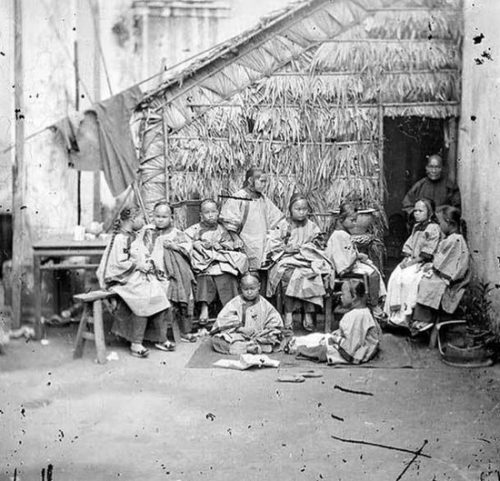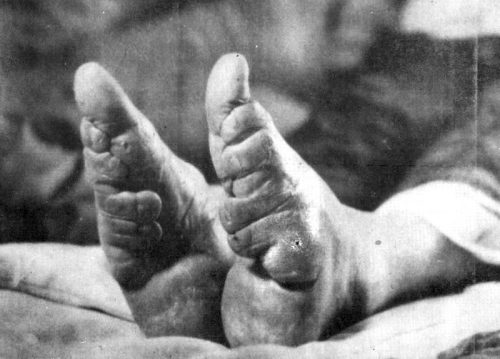
The Chinese Revolution began in a land of enormous but unfulfilled potential. Like modern China, ancient and imperial China also dominated its region. In the late 1800s territories under Chinese control or influence included Manchuria in the north and Burma, Tibet, Nepal and Turkestan in the south and south-west. By 1900, China’s population was approximately 467 million people, more than all the nations of Europe combined. The vast majority of Chinese citizens lived in the eastern half of the country, home to China’s coastline and ports as well as 90 per cent of its farming land. The vast majority of China’s people were concentrated in eastern provinces and cities, such as the imperial capital Beijing (called “Peking” by foreigners). Population density was much higher in eastern China, sometimes in excess of 200 people per square kilometre. China’s western regions, with their high mountain ranges, dry desert plateaus and less hospitable climate, were more sparsely populated.
Peasant communities were susceptible to natural disasters and climate events. A disaster of average scale, such as a prolonged drought, could disrupt production, ravage crops, spoil harvests and trigger devastating famines. Millions of Chinese peasants lived in the valleys and floodplains of great rivers such as the Yangtze and Huang He (Yellow River), so their lives and production were often affected by floods. China was also susceptible to earthquakes, which often caused high death tolls (the Tangshan earthquake, which struck a few weeks before the death of Mao Zedong in 1976, killed almost 250,000 people). Yet despite their parlous conditions and economic deprivation, Chinese peasants showed more independence and free thinking than their counterparts in medieval Japan or Europe. Chinese history is replete with stories of rural and provincial rebellions. It was not uncommon for suffering or mistreated peasants to lose faith with incumbent rulers and shift their support to a new dynasty, warlord or foreign invaders.

Peasants formed the vast majority of China’s population but there were other social classes, some of them curious, creative and progressive. Ancient and medieval China was well known for its technological innovations, including silk, paper and gunpowder, all of which were acquired and used by the West. China’s famous Great Wall was another engineering marvel, constructed and reconstructed over the course of a millennia to keep out rampaging warlords. Chinese cities and towns also had a thriving artisan class. These workmen produced manufactured goods like porcelain and silk, items later craved by European importers. Yet despite the high quality and strong demand for their wares, Chinese artisans were not an affluent class. They profited little from the sale of their items, most going into the hands of government officials, middlemen and foreign merchants. China also boasted a surprising amount of technical and industrial production, exceeding that of Europe, as historian Paul Kennedy summarised in The Rise and Fall of the Great Powers (1989):
“To readers brought up to respect “western science”, the most striking feature of Chinese civilisation must be its technological precocity. Huge libraries existed from early on. Printing by movable type had already appeared in 11th-century China, and soon large numbers of books were in existence. Trade and industry, stimulated by the canal building and population pressures, were equally sophisticated… By the later decades of the 11th century there existed an enormous iron industry in northern China, producing around 125,000 tons per annum, chiefly for military and government use – the army of over a million men was, for example, an enormous market for iron goods… This production figure was far larger than the British iron output in the early stages of the Industrial Revolution, seven centuries later! The Chinese were probably the first to invent true gunpowder. Cannons were used by the Ming to overthrow the Mongol rulers in the late 14th century. The magnetic compass was also another Chinese invention. In 1420, the Ming navy was recorded as possessing 1,350 combat vessels, including 400 large floating fortresses and 250 ships designed for long-range cruising.”

As in other feudal civilisations, medieval Chinese society was hierarchical, family-based and patriarchal. These structures were reinforced by the philosophical teachings of Confucius, who emphasised notions of hard work, obedience and respect for authority and one’s ancestors. Chinese women were subordinate in this social system. Men retained power and property through primogeniture: all titles and property were inherited by and remained with male descendants. Chinese women had few legal rights, no capacity to initiate divorce and no political voice. They received little in the way of formal education (women were schooled enough to read Confucian texts that reinforced their lowly position in society but that was all). Older women came to command some respect and influence: they could determine important family decisions, such as the selection of spouses for children, however like all women they had no formal or legal entitlements. Chinese law and Confucian values permitted only one wife. Affluent and powerful men often kept several concubines (in effect, public mistresses or unofficial wives). In most cases, these concubines had even fewer rights than married women.
“Although China’s population has always been overwhelmingly comprised of farmers, and although China was long thought of in the West as the very model of an agrarian society, by the mid-Qing era it was possibly the most commercialised country in the world. Chinese elites who claimed to live the idealised gentleman-farmer life of ‘ploughing and reading’ more often than not were subsidised by a family fortune made from trade. Western ‘pioneers of commerce’ who came to China in the 19th century, thinking they were teaching the natives the virtues of exchange, were simply deluding themselves… China’s domestic trade developed well before the arrival of Westerners.”
William T. Rowe, historian
In addition to their low social position, several million Chinese women were subjected to the horrors of foot binding. This ancient practice involved permanently modifying the shape of the human foot – but the process by which this was achieved was torturous. Young girls aged between two and four years had their toes broken and forced up under their soles, then the feet were tightly swathed in bandages. The feet were unbound, cleaned and soaked daily, then rebound even more tightly. Over time the structure of the feet was distorted, to the point where they could be unbound yet still retain their new form. The end result was a ‘lotus foot’, with a distinctive shape, high arch and exaggerated point. Foot binding conformed to prevailing male attitudes about beauty, shape and sexual appeal. The cleft in ‘lotus feet’ was even used by some Chinese men for sexual intercourse. The practice of foot binding was more widespread among the middle- and upper-classes, who considered ‘lotus feet’ a prerequisite for finding a good husband. Though some peasants bound the feet of their daughters, many did not because it made work in the fields virtually impossible. To Europeans, the practice of foot binding seemed cruel and barbaric.

1. Before the revolution, China was dominant in Asia, a nation of great size, enormous population and considerable economic potential.
2. The majority of China’s population were concentrated in its eastern provinces, near good farmland and the coast, while its mountainous and arid western regions were sparsely populated.
3. China’s economy was predominately agrarian, a land of peasants, though its industrial and manufacturing was well advanced in comparison to much of the world.
4. Chinese society was strongly hierarchical. These hierarchies and traditions were defined by tradition and reinforced by Confucian values of discipline and obedience.
5. Women occupied a lowly place in pre-revolutionary Chinese society, with few if any legal and property rights. Many Chinese women were also subject to the practices of foot binding and concubinage.
© Alpha History 2018. Content on this page may not be republished or distributed without permission. For more information please refer to our Terms of Use.
This page was written by Glen Kucha and Jennifer Llewellyn. To reference this page, use the following citation:
G. Kucha & J. Llewellyn, “An introduction to China“, Alpha History, accessed [today’s date], https://alphahistory.com/chineserevolution/introduction-to-china/.
This website uses pinyin romanisations of Chinese words and names. Please refer to this page for more information.
